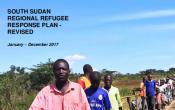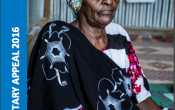Ethiopia
Operation: Ethiopia
Location
{"longitude":40,"latitude":9,"zoom_level":0}
Latest update of camps and office locations 21 Nov 2016. By clicking on the icons on the map, additional information is displayed.
Key Figures
| 2016 end-year results | |
| 62% | of primary school-aged children were enrolled in primary education |
| 12,950 | best interest assessments were conducted |
| 2,000 | refugee resettlement cases (7,037 individual were submitted to relevant countries |
| 18.1 | litres of water were made available per refugee per day; 11 out of 25 camps met the standard of 20 litres/person/day |
| 0.2/1,000 | the monthly under 5 mortality rate; meeting the international standard of <1.5/1,000/month |
| 2017 planning figures | |
| 100% | of unaccompanied and separated children from Eritrea will have a best interest process initiated or completed |
| 100% | of those whom are identified as being in need of resettlement will be submitted for resettlement |
| 65% | of South Sudanese school age refugee children will be enrolled in primary education |
| <15% | the percentage of Somali refugees who suffer from acute malnutrition will be reduced or kept below 15 per cent of the population |
Latest Updates and Related Links
People of Concern
7%
Increase in
2016
2016
| 2016 | 794,133 |
| 2015 | 739,156 |
| 2014 | 665,240 |

[["Refugees",791631],["Asylum-seekers",1964],["Returned refugees",1],["Others of concern",537]]
Loading ...
Ethiopia
< Back
2016
{"categories":[2012,2013,2014,2015,2016,2017],"budget":[218.65838219,193.15087926,283.71879953,311.641954085,279.32741856,330.47780759],"expenditure":[102.63756841,105.80377323,175.31367849,152.1095677,135.61655247,null]}
{"categories":[2012,2013,2014,2015,2016,2017],"p1":[218.21099923,192.99460025,283.71879953,311.641954085,279.32741856,330.47780759],"p2":[0.36238296,0.15627901,null,null,null,null],"p3":[null,null,null,null,null,null],"p4":[0.085,null,null,null,null,null]}
{"categories":[2012,2013,2014,2015,2016,2017],"p1":[102.57188121,105.7491314,175.31367849,152.1095677,135.61655247,null],"p2":[0.06441077,0.05464183,null,null,null,null],"p3":[null,null,null,null,null,null],"p4":[0.00127643,null,null,null,null,null]}
Loading ...
CHOOSE A YEAR
- 2014
- 2015
- 2016
- 2017
Working environment
Ethiopia hosted the second largest refugee population in Africa and continued to receive a steady influx of asylum-seekers from some 20 countries, mainly from Eritrea, Somalia, South Sudan and Sudan.Ethiopia is a party to both the 1951 Convention relating to the Status of Refugees and its 1967 Protocol, as well as the 1969 OAU Convention Governing the Specific Aspects of the Refugee Problems in Africa; finally, Ethiopia is party to the 2009 AU Convention for the protection and assistance of internally displaced people in Africa.
In 2016, Ethiopia continued to maintain an open-door policy and no cases of refoulement were reported. Although Ethiopia maintained reservations on the right to work, freedom of movement and limited access to residing out of the camps to a specific number of Eritrean refugees, the Government of Ethiopia made a set of highly significant commitments to strengthen refugee protection at the “Leaders’ Summit on Refugees”, held in the United States in September 2016. Although the implementation of these pledges will require significant donor support, the Government of Ethiopia’s Administration for Refugees and Returnee Affairs (ARRA), UNHCR, government ministries, donors, and other relevant stakeholders, are working to translate these pledges into outcomes which will strengthen refugee protection and assistance, and allow refugees to become self-reliant.
Resettlement remained the only viable durable solution.
Population trends
- At the end of 2016, the number of registered population stood at approximately 793,000 refugees (228,600 families), a 7 per cent increase compared with 2015.
- The South Sudanese refugee population remained the largest group in refugees hosted by Ethiopia, with some 338,800 people (43 per cent), followed by Somalian refugees with 241,600 people (30 per cent), Eritrean refugees with 165,300 people (21 per cent) and Sudanese refugees with 40,400 people (5 per cent).
- Throughout 2016, Ethiopia received close to 86,600 new arrivals. This included a steady foreseen influx of Eritreans and small numbers of Somalis, and an unforeseen influx of some 54,700 from South Sudan fleeing renewed violence and food shortages.
- Spontaneous voluntary returns to Somalia did not take place in 2016 as anticipated in 2015; based on data from ongoing monthly food distributions supporting registered refugees. Therefore, the Somali refugee population did not decrease as expected during 2015 planning.
Achievements and impact
- The gender-based violence information management system (GBVIMS) was rolled out in different field offices to strenghten the data collection, analysis and ethical sharing, as well as referral mechanisms and relevant responses. The coordination mechanisms on SGBV and child protection have been strengthened through the national sub-working group coordination meetings at the national and field levels.
- On-site biometric verification at the points of food distribution was fully established and implemented in all the camps in Assosa, Gambella, Melkadida, Shire and Samara in 2016. A data-sharing agreement was signed with the Administration for Refugees and Returnee Affairs of the Government of Ethiopia and resulted in the elaboration of a multi-year plan of action. Furthermore, it was agreed to include refugees in the national census which is foreseen to take place in November 2017.
- In June 2016, UNHCR conducted a joint workshop with the Ministry of Foreign Affairs on 1954 Convention relating to the Status of Stateless Persons and the 1961 Convention on the Reduction of Statelessness, to further dialogue on the issues of statelessness in Ethiopia. As a result, agreement was reached to undertake a comprehensive nation-wide study on statelessness to support further dialogue.
- UNHCR strenghtened its collaboration with the Ministries of Health and Education, with the aim of facilitating a stronger and longer-term refugee response.
Unmet needs
- Malnutrition remains a key challenge in addition to health, WASH and education.
- The high number of unaccompanied and separated children, as well as other vulnerable children, requires a comprehensive approach to ensure their specific needs are addressed, including family reunification.
- In the area of education, in spite of all the progresses made in 2016, the quality of education was poor and the operation could not meet the minimum standards in some of the indicators such as student classroom ratio, and teacher-student ratio.
- Targeted support to vulnerable refugees who are in need of protection in the complex urban setting needs to be strengthened through continuous support to the refugee outreach volunteer (ROV) programme
- Provision of domestic energy is one of the most critical challenges for the operation. To date, there is no practical or reliable solution to the energy shortage in most of the camps.
Ethiopia is hosting the largest number of registered refugees in Africa. The Government of Ethiopia maintains an open-door policy, allowing humanitarian access and protection to those seeking refuge on its territory. The Government has also generously provided land to accommodate refugees in the country.
In 2016, UNHCR will focus on stabilizing the emergency phase of the operation launched to respond to the influx of over 200,000 South Sudanese refugees in 2014 and 2015, while also undertaking emergency response activities for new arrivals.
UNHCR’s strategy in 2016 will be to safeguard the institution of asylum in Ethiopia and mainstream protection as a cross-cutting theme across all sectors; prevent refoulement and detention; address sexual and gender-based violence and child protection needs; and facilitate refugee status determination. UNHCR will continue to seek to maintain the civilian character of all refugee camps in Ethiopia and to strengthen the security of refugees.
Given the ever increasing number of new arrivals, one of the main challenges for the Office is to maintain basic minimum services and standards of assistance. In this respect, UNHCR will seek innovative, cost-effective and sustainable ways to meet basic needs and deliver essential services, including life-saving activities.








